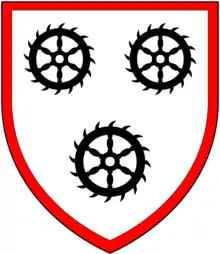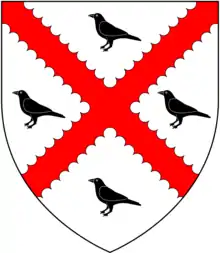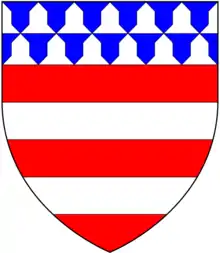Scot's Hall
Scot's Hall (or Scott's Hall) is a country house in Smeeth, between Ashford and Folkestone in southeast England. It was the property of a gentry family, the Scotts. The first known resident was Sir John Scott (born 1436), who married Caroline Carter.[1]

From the beginning of the fourteenth century to the end of the eighteenth century, the Scotts, who were the descendants of the Baliols, were influential in Kent, also owning Chilham Castle. Scott's Hall was the centre of the dynasty and there was a time when one could ride from Scot's Hall to London without leaving Scott Property,[2] a journey of over fifty miles. During the reign of Elizabeth I, it was described as one of the most splendid houses in Kent.[2] Samuel Pepys was a regular visitor in the seventeenth century: the contemporary owner, Sir Thomas Scott, married Caroline Carteret, daughter of Pepys' friend and colleague, Sir George Carteret. With his keen nose for gossip, Pepys noted that Thomas' right to inherit the estate was debatable: his parents were separated, and his father for a time refused to acknowledge any of his wife's children, although he ultimately did acknowledge Thomas as his son.[3]
The Modern Era
In recent years, Scott's Hall has been the venue for a series of annual murder mystery events, described by one anonymous reviewer as the 9/11 of House Parties. (This statement should be sourced. Multiple documents state that Scot's Hall was burned in the 1800s and is now left without a trace).
Descent
William Scott (d.1434)
William Scott (d.1434) married Isabel Finch (died c.1457), youngest daughter of Vincent Finch (alias Herbert), of Netherfield, Sussex. His son and heir was John Scott (c.1423-1485) of Scot's Hall.
John Scott (c.1423-1485)

John Scott (c.1423-1485) of Scot's Hall was a committed supporter of the House of York. Among other offices, he served as Comptroller of the Household to Edward IV, and lieutenant to the Lord Warden of the Cinque Ports. He was the son of William Scott (d.1434) and Isabel Finch (died c.1457), youngest daughter of Vincent Finch, or Herbert, of Netherfield, Sussex. He married Agnes Beaufitz (d.1486/7), daughter and co-heiress of William Beaufitz (alias Bewfice) of The Grange, Gillingham, Kent, and likely also a fishmonger of London, by whom he had a son and two daughters including:
- Sir William Scott (d. 24 August 1524), who married Sibyl Lewknor.
- Isabel or Elizabeth Scott (d. 15 August 1528), whom Sir John Scott married to his ward, Sir Edward Poynings. There is a memorial brass to her in St Mary's Church, Brabourne.
He died 17 October 1485, and was buried, by his instructions, in the north wall of the chancel of St. Mary's church, Brabourne.
William Scott (1459-1524)

Sir William Scott (1459-1524) of Scot's Hall in Smeeth, Kent was Lord Warden of the Cinque Ports. He was the son of Sir John Scott and Agnes Beaufitz, daughter and co-heiress of William Beaufitz. He married Sibyl Lewknor, the daughter of Sir Thomas Lewknor (d.1484) of Trotton, Sussex, and Katherine Pelham (d.1481), widow of John Bramshott (d.1468), and daughter of Sir John Pelham, Chamberlain to Queen Catherine of Valois. His son and heir was Sir John Scott (d.1533), who married Anne Pympe. He was buried at Brabourne, where there is a memorial brass to him in the Scott chapel in St Mary's church.
Sir John Scott (c. 1484-1533)

Sir John Scott (c. 1484 – 7 October 1533) was the eldest son of Sir William Scott of Scot's Hall. He served in King Henry VIII's campaigns in France, and was active in local government in Kent and a Member of Parliament for New Romney. He was the grandfather of both Reginald Scot, author of The Discoverie of Witchcraft, a source for Shakespeare's Macbeth, and Thomas Keyes, who married Lady Mary Grey. He married, before 22 November 1506, Anne Pympe, daughter and heiress of Reynold Pympe, esquire, of Nettlestead, Kent, by Elizabeth Pashley, the daughter of John Pashley, esquire.[4] Sir John Scott and Anne Pympe had five sons and seven daughters:[5]
- William Scott, who died in 1536 without issue.[6]
- Sir Reginald (or Reynold) Scott (1512–15 December 1554), Sheriff of Kent in 1541–42 and Captain of Calais and Sandgate, who married firstly Emeline Kempe, the daughter of Sir William Kempe of Olantigh, Kent, by Eleanor Browne, the daughter of Sir Robert Browne, by whom he was the father of Sir Thomas Scott (1535–30 December 1594) and two daughters, Katherine Scott, who married John Baker (c.1531–1604×6), by whom she was the mother of Richard Baker, and Anne Scott, who married Walter Mayney. Sir Reginald Scott married secondly Mary Tuke, the daughter of Sir Brian Tuke.[7]
- Sir John Scott.
- Richard Scott, esquire, the father of Reginald Scot (d. 1599), author of The Discoverie of Witchcraft.[6]
- George Scott.
- Mildred Scott, who married firstly, John Digges, esquire, the son of James Digges and half brother of Leonard Digges, and secondly, Richard Keyes, gentleman, by whom she was the mother of Thomas Keyes, who married Lady Mary Grey.[8][9]
- Katherine Scott, who married Sir Henry Crispe.
- Isabel Scott, who married Richard Adams, esquire.
- Alice Scott.
- Mary Scott, who married Nicholas Ballard, gentleman.
- Elizabeth Scott.
- Sibyl Scott, who married Richard Hynde, esquire.
Sir Reginald Scott (1512–1554)
Sir Reginald (or Reynold) Scott (1512–15 December 1554), Sheriff of Kent in 1541–42 and Captain of Calais and Sandgate, who married firstly Emeline Kempe, the daughter of Sir William Kempe of Olantigh, Kent, by Eleanor Browne, the daughter of Sir Robert Browne, by whom he was the father of Sir Thomas Scott (1535–30 December 1594) and two daughters, Katherine Scott, who married John Baker (c.1531–1604×6), by whom she was the mother of Richard Baker, and Anne Scott, who married Walter Mayney. Sir Reginald Scott married secondly Mary Tuke, the daughter of Sir Brian Tuke.
Sir Thomas Scott (1535–1594)
Sir Thomas Scott (1535–1594) (son of Sir Reginald Scott (1512–1554)) of Scot's Hall in Kent, was an English Member of Parliament (MP). He married three times:
- Firstly to Elizabeth Baker (d. 17 November 1583), the daughter of Sir John Baker of Sissinghurst and sister-in-law of Thomas Sackville, 1st Earl of Dorset, by whom he had ten sons and four daughters:
- Sir Edward Scott.
- Thomas Scott, esquire.
- Sir John Scott of Nettlestead, Kent, who married, as his second wife, Katherine Smythe, widow of Sir Rowland Hayward and daughter of Thomas Smythe, Customer of London. He was a Member of Parliament for Kent and an early investor in the Colony of Virginia.
- Richard Scott, who married Katherine Hayward, daughter of Sir Rowland Hayward.
- Robert Scott.
- Reginald Scott.
- Sir William Scott.
- Joseph Scott.
- Anthony Scott.
- Benjamin Scott.
- Elizabeth Scott, who married firstly John Knatchbull, and secondly, in 1589, Sir Richard Smythe (d.1628),[1] the son of Thomas Smythe, Customer of London.
- Emeline Scott, who married Sir Robert Edolphe.
- Anne Scott, who married firstly Richard Knatchbull, and secondly Sir Henry Bromley.
- Mary Scott, who married Sir Anthony St. Leger (d.1603), of Ulcombe and Leeds, Kent, eldest son and heir of Sir Warham St Leger by his first wife, Ursula Neville, youngest daughter of George Neville, 5th Baron Bergavenny, by whom she was the mother of Sir Warham St Leger (d. 11 October 1631), who married Mary Hayward (d.1662), daughter of Sir Rowland Hayward. After the death of Sir Anthony St. Leger in 1603, his widow, Mary Scott, married Sir Alexander Culpeper (d. 15 April 1636) of Wigsell, Sussex.
- Secondly he married Elizabeth Heyman (d.1595), the daughter of Ralph Heyman of Somerfield, by whom he had no issue.
- Thirdly he married Dorothy Bere, the daughter of John Bere of Horsman's Place, Dartford, by whom he had no issue.
Sir John Scott (1570-1616)
Sir John Scott (1570-1616), of Scot's Hall and of Nettlestead Place in Kent, was an English soldier, Member of Parliament (MP) and an early investor in the Colony of Virginia. He married twice, but had no issue:[10]
- Firstly, in 1590, to Elizabeth Stafford (c. 1546 – 6 February 1599), widow of Sir William Drury (30 May 1550 – 18 January 1590) of Hawstead, Suffolk, and daughter of Sir William Stafford (d. May 1556) by his wife, Dorothy Stafford (1 October 1526 – 22 September 1604), granddaughter of Edward Stafford, 3rd Duke of Buckingham. By his first marriage, Scott was the stepfather of Sir Robert Drury, friend of the poet, John Donne. Without issue.
- Secondly, before 17 September 1599, he married Katherine Smythe, widow of Sir Rowland Hayward, Lord Mayor of London, and daughter of Thomas Smythe (d.1591). She was baptised Katherine Smith on 6 Dec 1561 at All Hallows Lombard Street, City of London and is recorded in the Smythe pedigree taken during the Heraldic Visitation of London in 1568 and the Visitation of Kent in 1619 as the daughter of Thomas Smythe and Alice Judde. Without issue.
References
- Rootsweb.
- Scott Family History.
- The Diary of Samuel Pepys.
- Richardson II 2011, p. 311; Richardson IV 2011, pp. 1–2; Bindoff 1982, p. 465; Rigg 1897, p. 107
- Richardson IV 2011, p. 1; Glencross 1922, pp. 363–4.
- Rigg 1897, p. 107.
- Rigg 1897, p. 107; Brown 1897, pp. 996–7; Richardson IV 2011, p. 2; Martin 2004.
- According to Bindoff and Sherwood, Thomas Keyes was the son of his father's second marriage to Mildred Scott, although Richardson states that Thomas Keyes was the son of his father's first marriage to Agnes Saunders.
- Bindoff 1982, p. 495; Sherwood 1908, pp. 196–8; Richardson I 2011, p. 81; Richardson II 2011, p. 311; Richardson IV 2011, pp. 1–2; Doran 2004.
- White 1918, p. 544; Rowe 2004.
- https://archive.org/stream/memorialsoffamil00scot/memorialsoffamil00scot_djvu.txt
- https://www.kentarchaeology.org.uk/Research/Pub/ArchCant/010%20-%201876/010-21.pdf
- https://books.google.ca/books?id=Cfg8AQAAIAAJ&pg=PA266&lpg=PA266&dq=scott+monuments+at+brabourne+church&source=bl&ots=sBKCCN_u7d&sig=TTmUuhDFwGJmB1n38oK_3E5h8ro&hl=en&sa=X&ved=2ahUKEwi99POj1IHfAhXl1IMKHeV0DkwQ6AEwD3oECAoQAQ#v=onepage&q=scott%20monuments%20at%20brabourne%20church&f=false
- Family History: - Memorials of the Family of Scott, of Scot's Hall, in the County of Kent by James Renat Scott, privately published, 1876